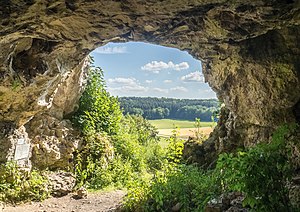Bockstein (arula)
|
Bockstein arula, tigisa koe Schwäbische Alb jakama getalte Germana, tir ayaf is abdiizvugalaf debak ke Lekeraporugal. Bockstein arula vatalte arteon Lone seg tigir. Bata betsa tir ke arulafa is butafa lospa ( tela ke Bockstein fluvoram ) tir dem nelkafa betsava abrotcafa vas 16 m- is mantafa vas 9 m-. Bana ina tir gluyawes do toleafa lopinafa betsava welmon ice mon 64 m². Refo kolanixo ke Bockstein arula bak 1880-e sanda tcon zo suxayar. Tuwavafo vansaxo ke arula, tukotranafo gu fulteyafa zuvda, bak 1950-e sanda zo koafizayar aze zo vestayar. Ba kosmara, bat tuwavaf remak ( germanavon Bocksteintörle ) zo ikseltayar nume va serixo evlon gu Milgaf Lekeraporugal ik Gelkeraporugal razdayar. Rawopaf mukeem ke Bockstein arula tir dem ingaxa epuyuna kum wula ok rapor. Aurignac Sare ke betsa gu 34000 ik 36000 AR tanda. zo uldiner. Tamavafa Gadakiewega[betara | va krent betá]Belca dem tevoya abdiizvugalafa arula ( don Bockstein arula ) milvemon tigisa getalte Germana va tano katcalapafo izvaxo ke tawava tadler nume bak 2007 wetce arayaf debak ke tamavafa gadakiewega ke UNESCO zo bendeyer.
Dere rupec[betara | va krent betá] |
| |||||||||||||||||||||||||||||||||||||||||||||||||||||||||
Vuestexa
[betara | va krent betá]
- (en) Fiona Coward is Robert Hosfield is Matt Pope is Francis Wenban-Smith, The Early Upper Paleolitic and the art of Central Europe, Settlement, Society and Cognition, ed. Human Evolution , Cambridge University Press, 2015, 448 p. [1]
- (en) Michael Bolus, The Swabian Jura, History of Research and the Aurignacian of the Sites in the Swabian Jura, Nuria Sanz, Human origin sites and the World Heritage Convention in Eurasia, ed. UNESCO, vol. n° 41, 2015, p. 166 [2]
- (en) Timothy Insoll, The Oxford Handbook of Prehistoric Figurines [3]
- (en) Andreas Taller is Michael Bolus is Nicholas J. Conard, The Magdalenian of Hohle Fels Cave and the Resettlement of the Swabian Jura after the LGM, Modes de contacts et de déplacements au paléolithique eurasiatique, Actes du Colloque international de l'UISPP, Université de Liège, 28–31/05/2012, coll. « Erault et Archéologiques », 2014, ISBN 978-2-87985-305-5 [4]
- (de, en) Ulrich Lehmann, Vogelherd und Bocksteinschmiede im Lonetal, Quaternary Science Journal, vol. 4-5, n°1, 1954 dene internetxo
- (de, en, fr) Robert Wetzel, Quartärforschung im Lonetal, Quaternary, Tübingen, 1954, n° 4-5, vol. 106 dene internetxo
- (de, en, fr) Robert Wetzel, Datierungsfragen am Bockstein, E&G Quaternary Science, Tübingen, 1957, n° 1, vol. 8 dene internetxo
- (en) Alvise Barbieri is Carsten Leven is Michael Toffolo, Bridging prehistoric caves with buried landscapes in the Swabian Jura, Quaternary International, 2017 dene internetxo






